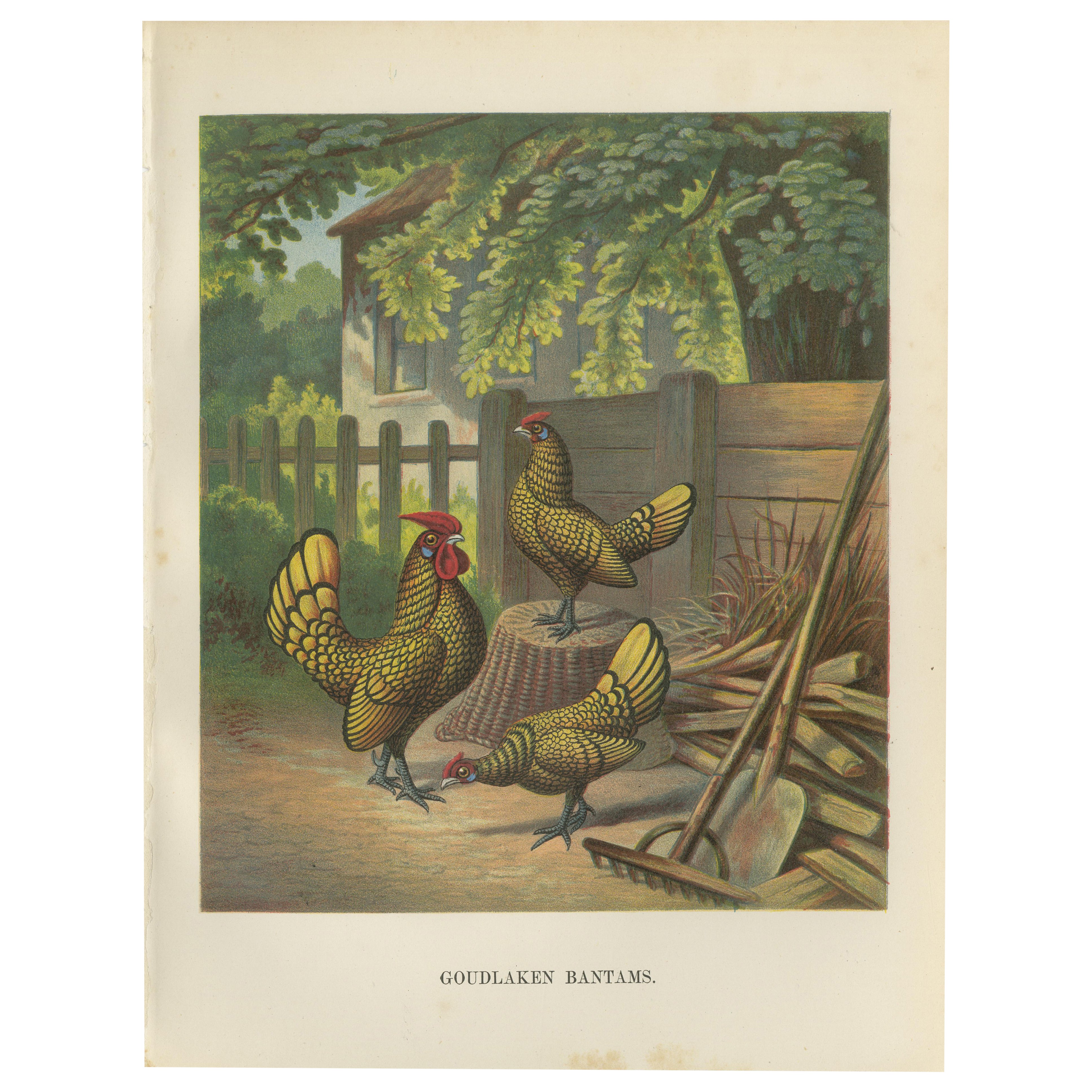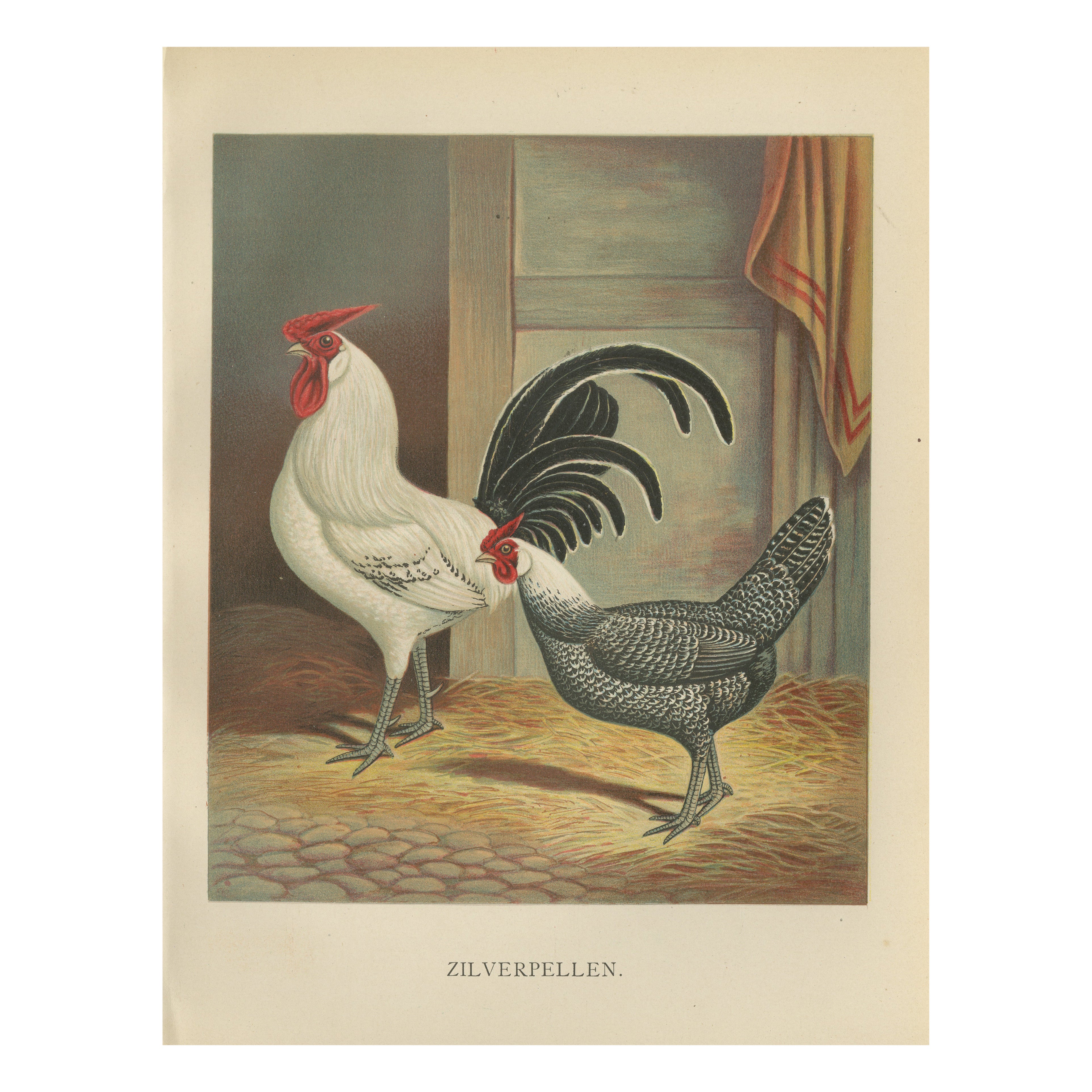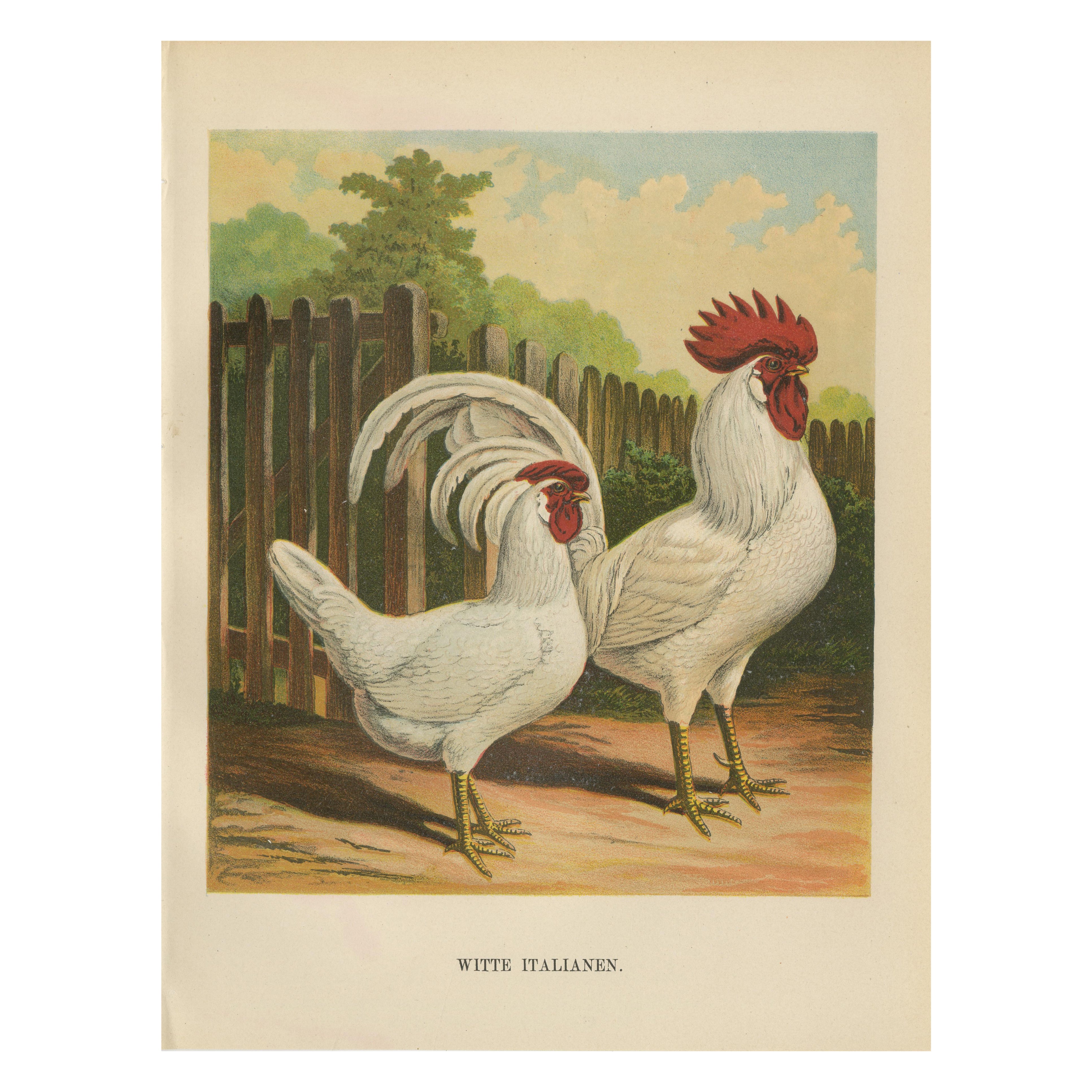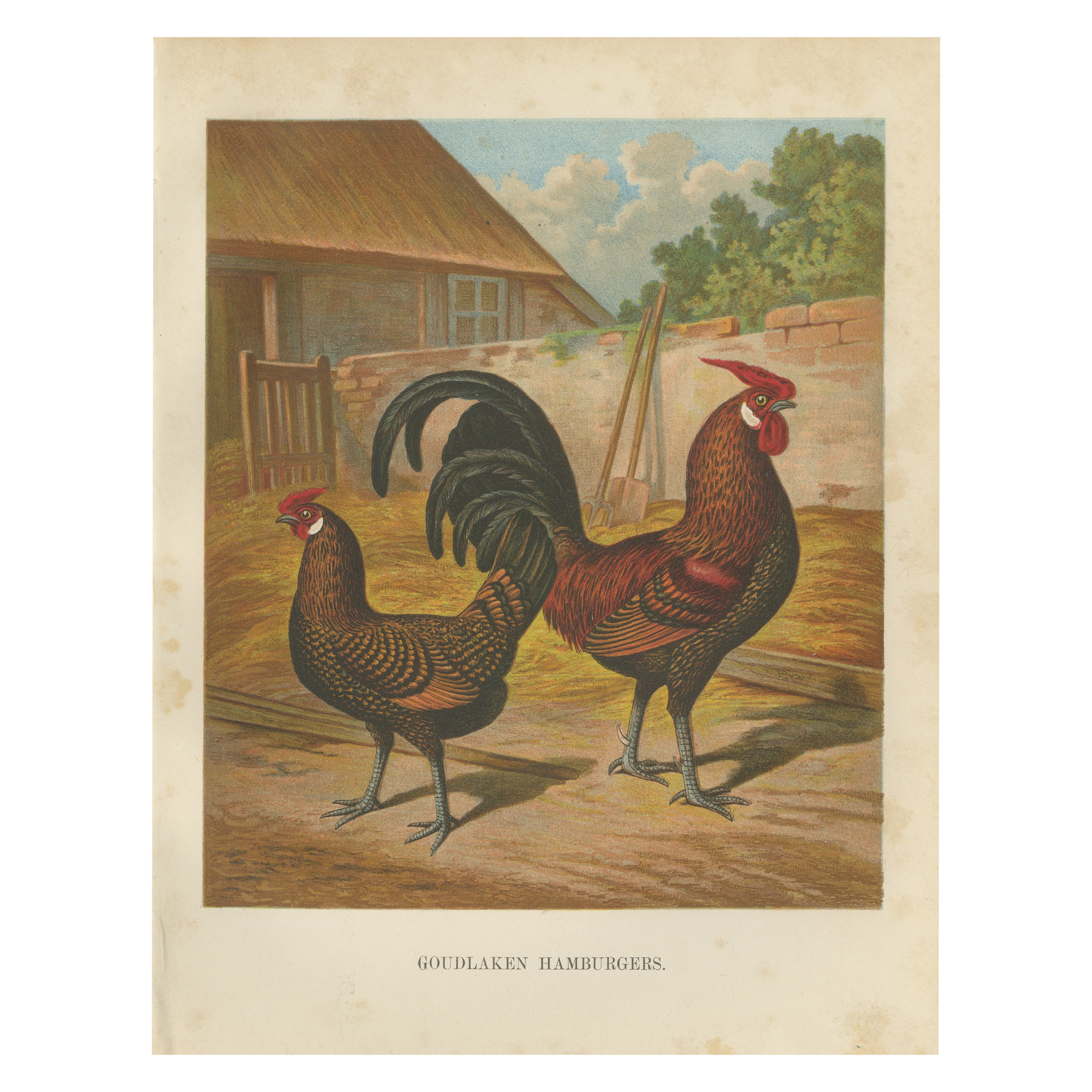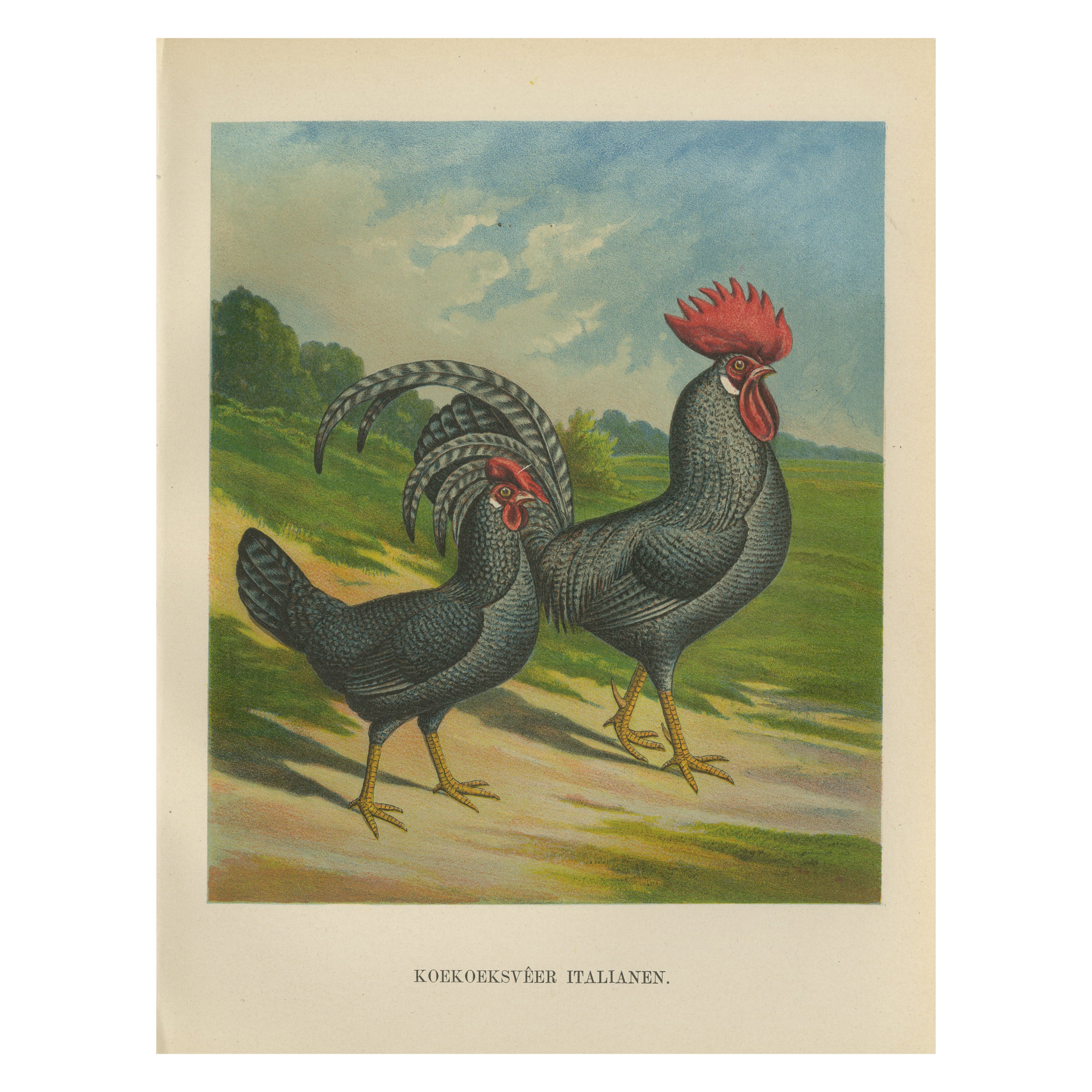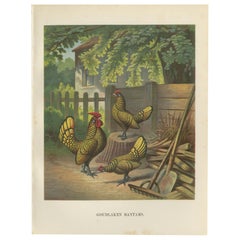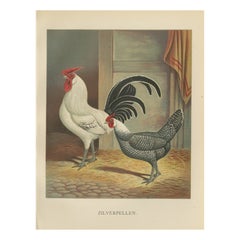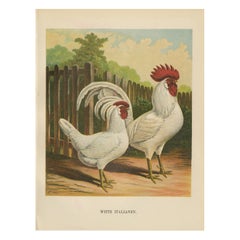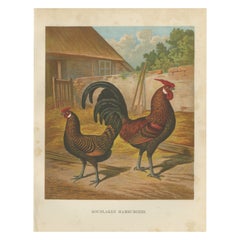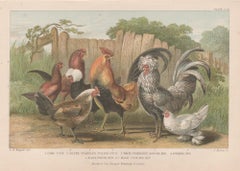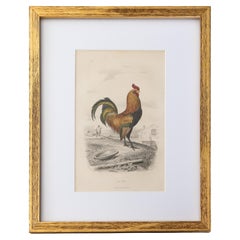Items Similar to The Silver-Laced Bantam - A Rare 19th Century Poultry Lithograph
Want more images or videos?
Request additional images or videos from the seller
1 of 10
The Silver-Laced Bantam - A Rare 19th Century Poultry Lithograph
$287.46
£213.02
€240
CA$392.43
A$436.57
CHF 228.85
MX$5,334.74
NOK 2,914.17
SEK 2,743.29
DKK 1,827.34
Shipping
Retrieving quote...The 1stDibs Promise:
Authenticity Guarantee,
Money-Back Guarantee,
24-Hour Cancellation
About the Item
The Silver-Laced Bantam - A Rare 19th Century Poultry Lithograph
This finely detailed 19th-century chromolithograph captures a lively group of Silver-Laced Bantams, an elegant and ornamental breed prized for its intricate feather patterning and refined stature. The print, titled Zilverlaken Bantams, originates from Geïllustreerd Hoenderboek, an Illustrated Poultry Book published in 1888 by Elsevier. Compiled by Julius Volschau and adapted for Dutch readers by Dr. A. C. Oudemans Jzn., this book provided an extensive guide to poultry breeding, featuring both productive and decorative breeds cherished by farmers and enthusiasts alike.
Silver-Laced Bantams, often linked to the Sebright breed, are among the most striking poultry varieties due to their exquisite plumage. Each feather is delicately edged in black, creating a laced effect over the bird's white and silver body. This contrast gives the birds a shimmering, almost metallic appearance. Unlike many poultry breeds, Sebright Bantams were developed purely for their ornamental value rather than for egg or meat production. Their small size, upright stance, and distinctive wing carriage make them one of the most admired and sought-after exhibition breeds.
In this lithograph, the rooster is depicted standing confidently on a wooden barrel, his wings neatly folded and tail feathers elegantly curved. Surrounding him are several hens, some foraging on the barn floor while others explore the open barn entrance. The rustic background, featuring a thatched roof, farm tools, and burlap sacks, adds to the scene’s charm and authenticity, giving insight into traditional 19th-century farmyard life.
This lithograph was created using the chromolithography technique, a highly refined 19th-century printing method that allowed for rich, multi-layered color printing. Each shade was applied with a separate stone plate, a labor-intensive process requiring exceptional precision. The result is a highly detailed and vibrant image that captures the intricacy of the birds' feather patterning with remarkable clarity. The artwork is based on an original drawing by Christian Förster, a noted animal illustrator of the period.
Condition Summary
The print is in good condition, with well-preserved colors and fine detail. Some light foxing and minor discoloration are visible along the edges, a common trait in antique lithographs of this age. The paper remains stable, with no significant tears or damage, making this a valuable addition to any collection of antique poultry prints or historical agricultural artwork.
Framing Tips
To best preserve and display this lithograph, consider the following framing techniques
- Use acid-free matting to prevent long-term deterioration. A neutral gray or soft silver mat will complement the silver-laced plumage
- Opt for UV-protective glass to prevent fading and preserve the intricate details of the print
- A classic dark wood frame, such as walnut or ebony, will provide an elegant contrast to the delicate white and silver tones of the birds
- Float mounting can be used if the original paper edges and margins are to be highlighted, adding a museum-quality effect
This lithograph is an exceptional representation of 19th-century poultry illustration, capturing the refined beauty of one of the most visually striking bantam breeds. Whether displayed in a study, library, or antique print collection, it remains a timeless and historically significant piece of agricultural art.
- Dimensions:Height: 10.63 in (27 cm)Width: 7.88 in (20 cm)Depth: 0.01 in (0.2 mm)
- Materials and Techniques:
- Period:
- Date of Manufacture:1888
- Condition:The print is in very good condition, with its colors remaining vibrant and well-preserved. Some minor age-related toning and light foxing are visible along the edges, a common characteristic of lithographs from this period.
- Seller Location:Langweer, NL
- Reference Number:Seller: BG-14012-351stDibs: LU3054344067572
About the Seller
5.0
Recognized Seller
These prestigious sellers are industry leaders and represent the highest echelon for item quality and design.
Platinum Seller
Premium sellers with a 4.7+ rating and 24-hour response times
Established in 2009
1stDibs seller since 2017
2,494 sales on 1stDibs
Typical response time: 1 hour
- ShippingRetrieving quote...Shipping from: Langweer, Netherlands
- Return Policy
Authenticity Guarantee
In the unlikely event there’s an issue with an item’s authenticity, contact us within 1 year for a full refund. DetailsMoney-Back Guarantee
If your item is not as described, is damaged in transit, or does not arrive, contact us within 7 days for a full refund. Details24-Hour Cancellation
You have a 24-hour grace period in which to reconsider your purchase, with no questions asked.Vetted Professional Sellers
Our world-class sellers must adhere to strict standards for service and quality, maintaining the integrity of our listings.Price-Match Guarantee
If you find that a seller listed the same item for a lower price elsewhere, we’ll match it.Trusted Global Delivery
Our best-in-class carrier network provides specialized shipping options worldwide, including custom delivery.More From This Seller
View AllThe Golden-Laced Bantam - A Rare 19th Century Poultry Lithograph
Located in Langweer, NL
The Golden-Laced Bantam A Rare 19th Century Poultry Lithograph
This beautifully detailed 19th-century chromolithograph depicts a charming group of Golden-Laced Bantams, a breed kn...
Category
Antique 1880s Prints
Materials
Paper
The Elegant Silver Penciled Chicken - A Rare 19th Century Poultry Lithograph
Located in Langweer, NL
The Elegant Silver Penciled Chicken - A Rare 19th Century Poultry Lithograph
This exquisite 19th century chromolithograph features a pair of Silver Penciled chickens, a breed celebrated for its striking contrast of black and white feather patterns and refined body shape. The print, titled Zilverpellen, originates from Geïllustreerd Hoenderboek, an Illustrated Poultry Book published in 1888 by Elsevier. Compiled by Julius Volschau and adapted for Dutch readers by Dr. A. C. Oudemans Jzn., this book provided detailed insights into poultry breeding, showcasing both practical and ornamental breeds that were highly valued in the 19th century.
Silver Penciled chickens were known for their intricate feather markings, particularly in the hens, which displayed an elegant silver and black penciling pattern across their bodies. The roosters, as depicted in this lithograph, feature a bright white body contrasted with a sharp black tail and wings, making them highly distinctive. This breed was admired not only for its aesthetic appeal but also for its energetic nature and steady egg laying capabilities.
This lithograph was created using chromolithography, a sophisticated 19th century printing process that allowed for vibrantly detailed and richly colored illustrations. The artwork is based on an original drawing by Christian Förster, a skilled animal illustrator of the time. Chromolithographs were produced by layering multiple colors, each applied with a separate stone plate, ensuring depth and realism in the final print. The precision in rendering the feather texture and silver toned contrast in this lithograph highlights the artistry involved in this technique.
Condition Summary
The print remains in very good condition, with well preserved colors and sharp details. Some minor age related toning and light foxing spots are visible, particularly along the edges, which is common in lithographs of this period. The paper remains stable, with minimal signs of wear, making this an excellent collectible piece for antique poultry print...
Category
Antique 1880s Prints
Materials
Paper
The Elegant White Italian Chicken - A Rare 19th Century Poultry Lithograph
Located in Langweer, NL
The Elegant White Italian Chicken A Rare 19th Century Poultry Lithograph
This striking 19th century chromolithograph features a pair of White Itali...
Category
Antique 1880s Prints
Materials
Paper
The Elegant Golden Spangled Hamburg Chicken - A 19th Century Poultry Lithograph
Located in Langweer, NL
The Elegant Golden Spangled Hamburg Chicken A Rare 19th Century Poultry Lithograph
This exquisite 19th century chromolithograph features a pair of Golden Spangled Hamburg chickens, an elegant and highly regarded breed known for its striking plumage, graceful build, and excellent egg laying capabilities. The print, titled Goudlaken Hamburgers, originates from Geïllustreerd Hoenderboek, an Illustrated Poultry Book published in 1888 by Elsevier. Compiled by Julius Volschau and adapted for Dutch readers by Dr. A. C. Oudemans Jzn., this book provided a comprehensive guide to poultry breeding, highlighting both practical and ornamental breeds that were highly valued in the 19th century.
Hamburg chickens are one of the oldest known domesticated poultry breeds, with records tracing them back to at least the 14th century. They were particularly popular in the Netherlands, Germany, and England due to their striking feather patterns and exceptional egg laying abilities. The Golden Spangled Hamburg, as depicted in this lithograph, is a particularly eye catching variety, featuring a rich golden brown base color accented with bold black spangling. The rooster stands tall with its flowing tail feathers and proud posture, while the hen, slightly smaller, displays the same intricate feather pattern in a more compact form.
This lithograph was created using chromolithography, a meticulous 19th century printing technique that allowed for vibrant and finely detailed illustrations. The artwork is based on an original drawing by Christian Förster, a skilled animal illustrator of the time. Chromolithographs were produced by layering multiple colors, each applied with a separate stone plate, ensuring depth and realism in the final print. The detailed feather patterning and the warm golden hues in this print highlight the craftsmanship involved in this artistic technique.
Condition Summary
The print remains in good condition, with well preserved colors and sharp details. Some minor age related toning and visible foxing spots are present along the edges, which is common in lithographs of this period. The paper remains stable, with slight signs of wear, making this an excellent collectible piece for antique poultry print...
Category
Antique 1880s Prints
Materials
Paper
The Striking Cuckoo Italian Chicken - A Rare 19th Century Poultry Lithograph
Located in Langweer, NL
The Striking Cuckoo Italian Chicken A Rare 19th Century Poultry Lithograph
This exquisite 19th century chromolithograph features a pair of Cuckoo Italian chickens, a breed distinguished by its beautiful barred plumage, elegant body shape, and alert expression. The print, titled Koekoeksvêer Italianen, originates from Geïllustreerd Hoenderboek, an Illustrated Poultry Book published in 1888 by Elsevier. Compiled by Julius Volschau and adapted for Dutch readers by Dr. A. C. Oudemans Jzn., this book provided a comprehensive guide to poultry breeding, showcasing both practical and ornamental breeds that were highly valued in the 19th century.
Cuckoo feathering, also known as barring, is a striking pattern where alternating bands of dark and light feathers create a rippling effect across the body. This coloration was favored in many European breeds for its camouflage benefits and visual appeal. The rooster in this lithograph stands with a commanding presence, displaying bold barring throughout its body and tail, while the hen exhibits a more subtle but equally refined version of this striking pattern. Both birds have bright red combs and wattles, providing a dramatic contrast to their cool-toned feathers.
This lithograph was created using chromolithography, a sophisticated 19th century printing process that allowed for richly detailed and vibrantly colored illustrations. The artwork is based on an original drawing by Christian Förster, a skilled animal illustrator of the time. Chromolithographs were produced by layering multiple colors, each applied with a separate stone plate, ensuring depth and realism in the final print. The detailed rendering of the barring pattern and subtle shading in this lithograph highlights the craftsmanship involved in this technique.
Condition Summary
The print remains in very good condition, with well preserved colors and sharp details. Some minor age related toning and light foxing spots are visible, particularly along the edges, which is common in lithographs of this period. The paper remains stable, with minimal signs of wear, making this an excellent collectible piece for antique poultry print...
Category
Antique 1880s Prints
Materials
Paper
The Regal Partridge Italian Chicken - A Rare 19th Century Poultry Lithograph
Located in Langweer, NL
The Regal Partridge Italian Chicken A Rare 19th Century Poultry Lithograph
This remarkable 19th century chromolithograph features a pair of Partridge Italian chickens, a breed admired for its striking plumage, graceful build, and lively temperament. The print, titled Patrijsveer-Italianen, originates from Geïllustreerd Hoenderboek, an Illustrated Poultry Book published in 1888 by Elsevier. Compiled by Julius Volschau and adapted for Dutch readers by Dr. A. C. Oudemans Jzn., this book provided an extensive guide to poultry breeding, detailing both functional and ornamental breeds highly regarded in the 19th century.
Partridge Italian chickens are a visually striking variety, displaying a rich combination of deep golden-brown, black, and chestnut hues. The rooster in this lithograph stands with an imposing posture, exhibiting its glossy black tail feathers and vibrant golden saddle feathers. The hens are equally beautiful, featuring finely patterned feathering on their backs and wings, transitioning into a warm golden-brown on their chests. This variety is not only known for its beauty but also for its excellent egg-laying abilities and hardy nature, making it a favorite among poultry breeders.
This lithograph was created using chromolithography, a highly skilled 19th-century printing process that allowed for vibrant, multi-colored illustrations. The artwork is based on an original drawing by Christian Förster, a well-known animal illustrator of the time. Chromolithography involved layering multiple colors, each applied with a separate stone plate, to achieve depth, shading, and fine detail. The precision in rendering the intricate feather textures and the interplay of light and shadow in this lithograph highlights the mastery of this technique.
Condition Summary
The print remains in very good condition, with its colors still rich and vibrant. Some minor age-related toning and light foxing are visible along the edges, a common characteristic of lithographs from this period. The paper is stable with minimal signs of wear, making it a valuable collectible for antique poultry print...
Category
Antique 1880s Prints
Materials
Paper
You May Also Like
Poultry, English antique bird engraving print, 1879
Located in Melbourne, Victoria
Poultry
Wood-engraving with original colouring. 1879.
160mm by 245mm (sheet).
Key below the image. From Oliver Goldsmith's 'A History of the Earth and Animated Nature'.
Category
Late 19th Century Victorian Animal Prints
Materials
Engraving
Chicken and Hens - Original Lithograph - Late 19th Century
Located in Roma, IT
Image dimensions: 18 x 24,3 cm.
Chicken and Hens is a color lithograph contained in the Meyers Konversations-Lexikon (or Meyers Lexikon).
The print is from the encyclopedia Meyers ...
Category
Late 19th Century Animal Prints
Materials
Lithograph
Chicken Family - Lithograph by W. French - Late 19th Century
Located in Roma, IT
A Chicken Family is an original print realized by William French (1815 ca.-1898) in the late 19th century.
Black and white lithograph. Original Title: ...
Category
Late 19th Century Animal Prints
Materials
Lithograph
Custom Framed Antique Rooster Engraving
By Georges-Louis Leclerc, Comte de Buffon
Located in Pearland, TX
Georges-Louis Leclerc, Count of Buffon (1707-1788) was a French naturalist, mathematician, and cosmologist. Buffon published thirty-six quarto volumes of his most well-known work, Hi...
Category
Antique 1850s French Decorative Art
Materials
Other
American Folk Art paintings of Chickens in Farm Landscape, signed 'Horiz'
Located in West Palm Beach, FL
American folk art painting of chickens in a farm landscape, signed 'Horiz'
USA, 20th century
A captivating American folk art painting depicting chickens in a picturesque farm lands...
Category
20th Century American Folk Art Paintings
Materials
Wood
$1,516 Sale Price
20% Off
Original Antique Print of Partridge, 1847 'Unframed'
Located in St Annes, Lancashire
Great image of partridge.
Unframed. It gives you the option of perhaps making a set up using your own choice of frames.
Lithograph after Cpt. brown with original hand color.
...
Category
Antique 1840s English Folk Art Prints
Materials
Paper
More Ways To Browse
Antique Farm Tools
4 M Long Dining Tables
6 Foot Mirror
8 Panel Asian Screens
African Fertility Sculpture
African Head Rest
African Spears
Antique African Pottery
Antique Bar Cart With Wheels
Antique Blanket Box Coffee Table
Antique Brass And Cast Iron Beds
Antique Brass Charger
Antique Brass Chargers
Antique Brass Log Basket
Antique Brass Utensils
Antique Brown Clay Planter
Antique Carved Coconuts
Antique Cast Iron Garden Fountain
